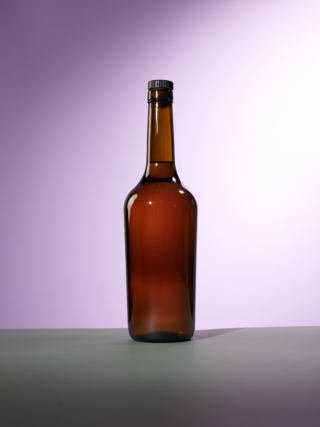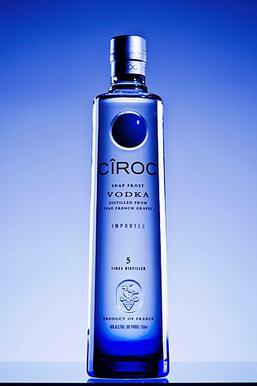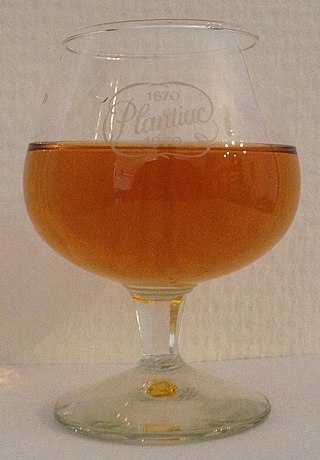Related Research Articles

Brandy is a liquor produced by distilling wine. Brandy generally contains 35–60% alcohol by volume and is typically consumed as an after-dinner digestif. Some brandies are aged in wooden casks. Others are coloured with caramel colouring to imitate the effect of aging, and some are produced using a combination of aging and colouring. Varieties of wine brandy can be found across the winemaking world. Among the most renowned are Cognac and Armagnac from south-western France.

Calvados is a brandy from Normandy in France, made from apples and/or pears.

Cognac is a variety of brandy named after the commune of Cognac, France. It is produced in the surrounding wine-growing region in the departments of Charente and Charente-Maritime.
Apéritifs and digestifs are drinks, typically alcoholic, that are normally served before (apéritif) or after (digestif) a meal respectively.

Pomace spirit is a liquor distilled from pomace that is left over from winemaking, after the grapes are pressed. It is called marc in both English and French, but "grappa" in Italian and "bagaço" in Portuguese. In Spanish it is called orujo. Alcohol derived from pomace is also used as the traditional base spirit of other liquors, such as some anise-flavored spirits. Unlike wine brandy, most pomace brandies are neither aged nor coloured.

Courvoisier is a brand of cognac, with production based in the town of Jarnac in the Charente region of France. It is the youngest and smallest of the "big four" cognac houses.

Baco blanc or Baco 22A is a French-American hybrid grape variety. It is a cross of Folle blanche and the Noah grape, created in 1898 by the grape breeder François Baco. Folle blanche is its Vitis vinifera parent. Noah, its other parent, is itself a cross of Vitis labrusca and Vitis riparia.

Cognac is a commune in the Charente department, southwestern France. Administratively, the commune of Cognac is a subprefecture of the Charente department.

Grande Champagne is a French district, called a cru, known for its cognac. It produces the finest cognacs in a zone of 34703 hectares, of which 17% is dedicated to production of cognac, which can be marked as Grande Champagne or Grande Fine Champagne. At its heart is the town of Segonzac, in the Département of Charente. Grande Champagne is situated entirely in this département.

Armagnac is a distinctive kind of brandy produced in the Armagnac region in Gascony, southwest France. It is distilled from wine usually made from a blend of grapes including Baco 22A, Colombard, Folle blanche and Ugni blanc, traditionally using column stills. This is in contrast to the pot stills used in the production of cognac, which is made predominantly from ugni blanc grapes. The resulting spirit is aged in oak barrels before release. Production is overseen by the Institut national de l'origine et de la qualité (INAO) and the Bureau National Interprofessionel de l'Armagnac (BNIA).

Cîroc is a brand of alcoholic beverages produced in France since 2003 and owned by the British-based multinational alcoholic beverage maker Diageo. The brand family includes vodka, flavored products containing vodka, and brandy. From 2007 the marketing and promotion for Cîroc in the United States was in conjunction with mogul Sean Combs in an "equal-share venture" with profits from the brand being split between Combs and Diageo, but this was terminated in 2024 after a legal dispute, leaving Diageo the sole owner.

Pineau des Charentes is a regional aperitif of western France, made in the départements of Charente, Charente-Maritime, and Dordogne. While popular within its region of production, it is less well known in other regions of France and somewhat uncommon abroad.

French wine is produced all throughout France, in quantities between 50 and 60 million hectolitres per year, or 7–8 billion bottles. France is one of the largest wine producers in the world, along with Italian, Spanish, and American wine-producing regions. French wine traces its history to the 6th century BCE, with many of France's regions dating their wine-making history to Roman times. The wines produced range from expensive wines sold internationally to modest wines usually only seen within France such as the Margnat wines of the post-war period.

Orujo is a pomace brandy from northern Spain. It is a transparent spirit with an alcohol content over 50%. Its name comes from the expression "aguardiente de orujo".
Fins Bois is a wine producing sub-region within the Cognac appellation, geographically surrounding the sub-regions of Grande Champagne, Petite Champagne and Borderies, and which falls within both the Charente and Charente-Maritime departments in South-West France, just north of Bordeaux.
Fruit brandy is a distilled beverage produced from mash, juice, wine or residues of edible fruits. The term covers a broad class of spirits produced across the world, and typically excludes beverages made from grapes, which are referred to as plain brandy or pomace brandy. Apples, pears, apricots, plums and cherries are the most commonly used fruits.

The Floc de Gascogne is a regional apéritif from the Côtes de Gascogne and Armagnac regions of Sud-Ouest wine region of France. It is a vin de liqueur fortified with armagnac, the local brandy. It has had Appellation d'origine contrôlée status since 1990. Elsewhere in France analogous drinks are made.

Faugères is an Appellation d'origine contrôlée (AOC) in the Languedoc-Roussillon wine region in France and is named after the town of Faugères, which lies 30 km north of Béziers, in the foothills of the Massif Central, in the département of Hérault. It is a local classification within the Coteaux-du-Languedoc AOC.

Dutch brandy is a distilled spirit made from either grain or molasses alcohol flavored with various essences and extracts produced in the Netherlands. It was formerly referred to as "Dutch cognac" until that name was legally restricted to grape brandy from the Cognac region of France. Dutch names included Koetsiertje or Koetsierscognac or Hollandse Cognac. Its colour ranges from clear to dark brown, reflecting added caramel or artificial dye.
References
- ↑ Courtine, Robert (1988). Larousse Gastronomique: the world's greatest cookery encyclopedia (Hardback). London: Hamlyn. p. 440. ISBN 0-600-32390-0 . Retrieved 26 September 2024.
- ↑ "Our appellations - Planète Bordeaux". www.planete-bordeaux.fr. Retrieved 26 September 2024.
- ↑ "Fine de Bourgogne". eauxdeviedebourgogne.com. Retrieved 26 September 2024.
- ↑ "Bugey Vineyard Appellations". vinsdubugey.net. Retrieved 26 September 2024.
- ↑ "Fine Faugères". www.faugeres.com. Retrieved 26 September 2024.